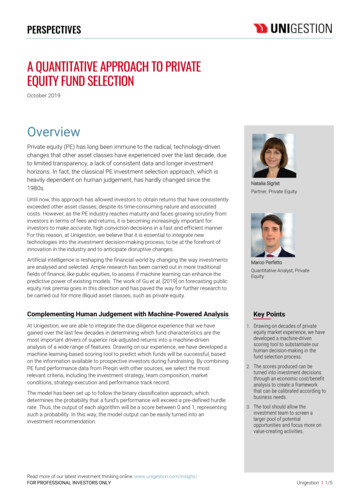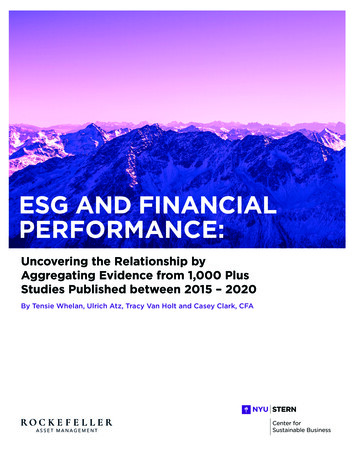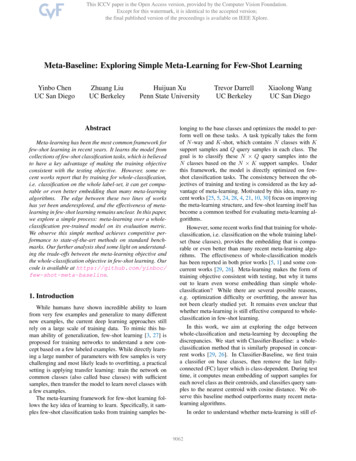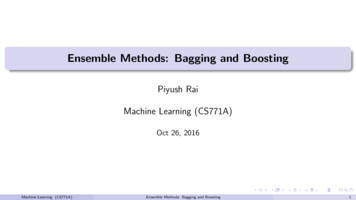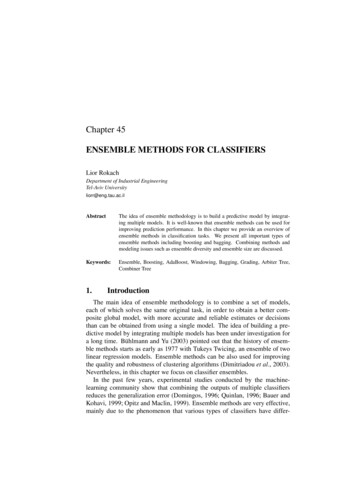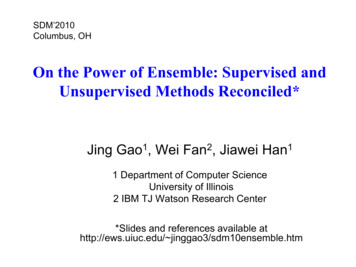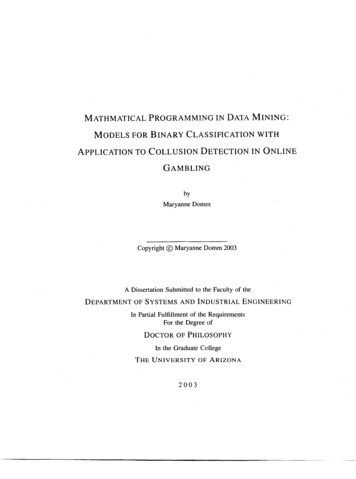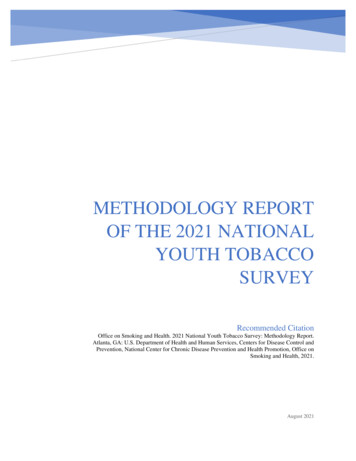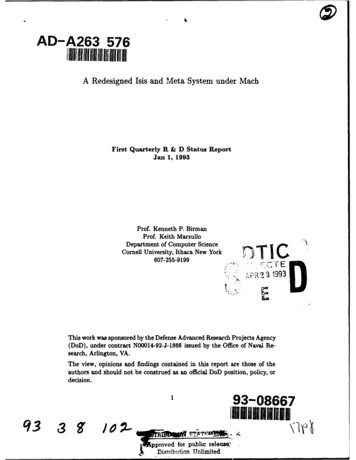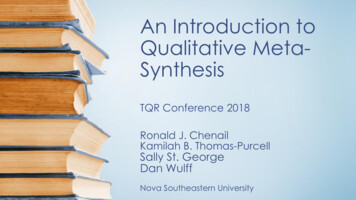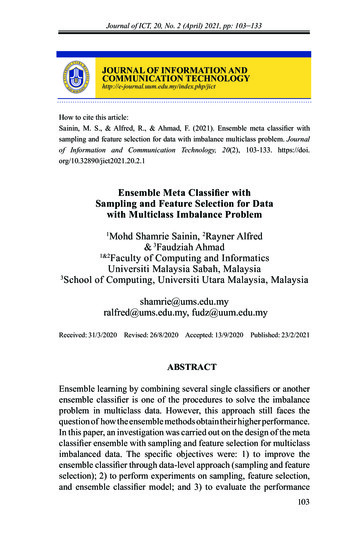
Transcription
Journal of ICT, 20, No. 2 (April) 2021, pp: 103–133JOURNAL OF INFORMATION ANDCOMMUNICATION ctHow to cite this article:Sainin, M. S., & Alfred, R., & Ahmad, F. (2021). Ensemble meta classifier withsampling and feature selection for data with imbalance multiclass problem. Journalof Information and Communication Technology, 20(2), 103-133. https://doi.org/10.32890/jict2021.20.2.1Ensemble Meta Classifier withSampling and Feature Selection for Datawith Multiclass Imbalance ProblemMohd Shamrie Sainin, 2Rayner Alfred& 3Faudziah Ahmad1&2Faculty of Computing and InformaticsUniversiti Malaysia Sabah, Malaysia3School of Computing, Universiti Utara Malaysia, Malaysia1shamrie@ums.edu.myralfred@ums.edu.my, fudz@uum.edu.myReceived: 31/3/2020Revised: 26/8/2020 Accepted: 13/9/2020Published: 23/2/2021ABSTRACTEnsemble learning by combining several single classifiers or anotherensemble classifier is one of the procedures to solve the imbalanceproblem in multiclass data. However, this approach still faces thequestion of how the ensemble methods obtain their higher performance.In this paper, an investigation was carried out on the design of the metaclassifier ensemble with sampling and feature selection for multiclassimbalanced data. The specific objectives were: 1) to improve theensemble classifier through data-level approach (sampling and featureselection); 2) to perform experiments on sampling, feature selection,and ensemble classifier model; and 3) to evaluate the performance103
Journal of ICT, 20, No. 2 (April) 2021, pp: 103–133of the ensemble classifier. To fulfil the objectives, a preliminarydata collection of Malaysian plants’ leaf images was prepared andexperimented, and the results were compared. The ensemble designwas also tested with three other high imbalance ratio benchmark data.It was found that the design using sampling, feature selection, andensemble classifier method via AdaboostM1 with random forest (alsoan ensemble classifier) provided improved performance throughoutthe investigation. The result of this study is important to the ongoing problem of multiclass imbalance where specific structure andits performance can be improved in terms of processing time andaccuracy.Keywords: Imbalance, multiclass, ensemble, feature selection,sampling.INTRODUCTIONWith the advancement of the industrial revolution 4.0, more dataare being captured, stored, processed, and analysed. Imbalanceproblem is still the leading challenge in real-world data and mostof the recent works proposed to address this problem. In machinelearning, a multiclass classification problem refers to assigningone of the several class labels with an input object. Unlike binaryclassification, learning a multiclass problem is a more complex tasksince each example can only be assigned to exactly one class label.Numerous attempts at using binary classification methods have failedto perform well in multiclass classification problems. There are threecategories of methods proposed for learning multiclass classificationproblems, namely 1) direct multiclass classification technique usinga single classifier; 2) binary conversion classification techniques;and 3) hierarchical classification techniques. A direct classifieris any algorithm that can be applied naturally to solve multiclassclassification problems directly, such as neural network, decision tree,k-Nearest neighbour (k-NN), Naive Bayes (NB), and support vectormachine (SVM) (Mehra & Gupta, 2013). In contrast, if the processrequires several steps to change, select, and preprocess certain databefore the classification, then it is called an indirect method, or alsoidentified as a hybrid approach.104
Journal of ICT, 20, No. 2 (April) 2021, pp: 103–133Many scholars in the related domain research argue that although adirect classifier algorithm can easily be applied to solve multiclassclassification problems, the performance of a single classifier is notencouraging when solving real-world problems. One of the possibleeffects of this problem is the existence of multiclass imbalanceddata. A multiclass imbalance problem refers to a dataset with a targetclass that is skewed in distribution and poses a significant effecton classifier performance. Ensemble classifiers offer a distinctivearrangement approach by joining the quality of a few single classifiers.This classifier has been suggested as the promising trend in machinelearning with different ensemble methods discussed in Ren et al.(2016) and Feng et al. (2018).This paper aims to find the possible hybrid of sampling, featureselection, and ensemble classifiers as well as the order of which process(feature selection and sampling) that may increase the performance ofthe overall process. The approach introduces the diversity in trainingdata and ensemble design. The investigation flow begins from thedataset, the effect of sampling and feature selection using singleclassifiers and then moves to ensemble classifiers. Fine-tuning theensemble design at the end of the phase is another crucial point asspecific settings and parameter tuning could improve the performanceand execution time.LITERATURE REVIEWA recent review by Ali et al. (2019) related to the imbalance problemin data mining showed that the issue of imbalance is still prevalent.In the paper, the issues are to distinguish between the imbalance ratiomeasurement and lack of information. Normally, the ratio is measuredas the number of minorities divided by the number of majorities.However, lack of information was not discussed. Other factors thatwere also considered when discussing imbalance are data overlapping,overfitting, small disjoint, small data, and high dimensionality. Thedetailed taxonomy of imbalance as proposed in the work is depicted inthe following Figure 1. According to the taxonomy, this work focusedon preprocessing (data-level method) and algorithmic method (featureselection) in a sequential process before ensemble learning is applied.105
Journal of ICT, 20, No. 2 (April) 2021, pp: 103–133Figure 1Taxonomy of Imbalanced Data, Solution, and Example Methods byAli et al. (2019).EnsembleMethodsFigure 1. Taxonomyof imbalanced data, solution, and example methods by Ali et al. (2019).An ensemble method is defined as an approach that applies severalsingle Methodsclassifiers or may combine more diverse learners where theEnsembleclassification will be identified using a method (known as a committeeAn ensemble method is defined as an approach that applies several single classifiers or may combineof expert decision) for classifying new unseen instances. As mentionedmore diverse learners where the classification will be identified using a method (known as aby Renof etexpertal. ethodscommitteeclassifyingnew unseeninstances. Asmentioned byRen et al.(2016),Weka offersconventionalensemblemethods includingrandom forest,rotationboosting d bagging,rotationforest, DECORATE,END,stacking.and stacking.Adaptive boostingboosting (AdaBoost)and baggingDECORATE,END, andAdaptive(AdaBoost)and(bootstrap aggregation) are the most popular techniques to construct ensembles, which leads chniquestosignificant improvement in some applications (Galar et al., 2012). Adaptive boosting or sproposed byensembles,Freund and Schapire(1996).It istoa popularensembleimprovementlearning . AdaptiveHowever, whenthe imbalanceproblem exists waswithinapplications(Galaretgeneralal., 2012).boostingor AdaBoostthe dataset, the algorithm cannot be applied directly to the training sample without much attention toproposed by Freund and Schapire (1996). It is a popular ensemblethe minority class (Li et al., 2019). Therefore, it is important to investigate the data level manipulationframeworkgood classification performance overoflearningthe dataset beforethe algorithmwithcan be applied.general datasets. However, when the imbalance problem exists withinBagging is an ensemble method introduced by Breiman (1996), where some base classifiers arethe dataset, the algorithm cannot be applied directly to the traininginduced by a similar learning algorithm and certain samples by bootstrapping. In this method, thesampleoperateswithoutmuch attentiontotrainingthe minorityclass (Liet al., 2019).ensembleon a bootstrappedportion ofdata using differentN classifiers.DifferentTherefore,is ts it(withreplacement) tofromthe original thedatasetare levelconstructedfor training eachthe dataset before the algorithm can be applied.Bagging is an ensemble method introduced by Breiman (1996), wheresome base classifiers are induced by a similar learning algorithmand certain samples by bootstrapping. In this method, the ensemble106
Journal of ICT, 20, No. 2 (April) 2021, pp: 103–133operates on a bootstrapped portion of training data using differentN classifiers. Different random datasets (with replacement) fromthe original dataset are constructed for training each classifier toachieve the ensemble diversity through resampling. Prediction bythe classifiers is finalised based on the equal weight majority voting(Jerzy et al., 2013). MultiBoostAB is the extension of the boostingmethod, specifically the AdaBoost algorithm, which constructsstrong decision committees (Webb, 2000). The algorithm combinesAdaBoost and wagging together by reducing the AdaBoost’s bias andvariance. It was reported that by using the decision tree of C4.5, themethod demonstrated a lower error more often when tested on a largerepresentative of the University of California Irvine (UCI) datasets.Diverse ensemble creation by oppositional relabelling of artificialtraining examples (DECORATE) is the ensemble method introducedby Melville and Mooney (2004), which manipulates and generatesdiverse hypotheses with syntactically produced training samples.The main advantage of DECORATE is the concept of diversity in theensemble constructed during the creation of artificial training instances.An ensemble of nested dichotomies or END is constructed usingstandard statistical techniques to address polytomous classificationproblems with logistic regression (Gu & Jin, 2014). It was originallyrepresented using binary trees that iteratively split multiclass data intoa system of dichotomies. Recent studies using END include hydraulicbrake health monitoring (Jegadeeshwaran & Sugumaran, 2015),adaptive nested dichotomies (Leathart et al., 2016), and evolvingnested dichotomies classifier with genetic algorithm for optimisation(Wever et al., 2018).In other ensemble designs, rotation forest is a classifier ensemble basedon feature extraction. It was introduced by Rodrı́guez and Kuncheva(2006) with the aim to acquire distinct accuracy and diversity in theensemble design. It works by preparing the portion of training samplesfor the base classifier, where a certain set of features are based on Krandom subsets. Then, the principal component analysis is performed,retaining each of the components to preserve the dataset informationvariability. Furthermore, the key factor for the algorithm to succeed isthe application of a transformation matrix for calculating the extractedfeatures that are sparse (Kuncheva & Rodrıguez, 2007). Since then, theensemble algorithm has been used in various studies such as ensemble107
Journal of ICT, 20, No. 2 (April) 2021, pp: 103–133model in spatial modelling of groundwater potential (Naghibi et al.,2019), comparing meta classifier approach based on rotation forest(Tasci, 2019), and applying rotation forest for imbalance problems(Guo et al., 2019). The sample works indicated that the performancewas improved on various evaluations.Stacking was first introduced by Wolpert (1992) based on the stackgeneralisation, where it tries to reduce the error rate using one or moreclassifiers. It is said to learn by induction of biases of the classifieraccording to the single training dataset and finally voting is appliedas the baseline method for combining the result of the classifier. Oneof the recent uses of this method is shown in Rajagopal et al. (2020)that discussed network intrusion detection. Based on the study, thestacking method is able to achieve superior performance as indicatedby the reported accuracy.Multiclass Imbalance ProblemWhen a dataset exists with an unequal number of examples betweenits classes, it is called an imbalanced data problem. Analysing andlearning from such distribution is a challenge. The general definitionof imbalanced data is that the classes sample is not 50:50 and can beviewed from minor (2:1 to 18:1) to highly imbalanced (19:1 or more).The multiclass classification problem becomes more difficult to besolved with the existence of a highly imbalanced dataset. Ding (2011)stated that if the imbalance ratio in a general classification problemis no less than 19:1 with a minority class size of only 5 percent ofthe entire data size, then it is called the learning problem of a highlyimbalanced classification problem (imbalance learning).A high imbalance ratio is defined from the problem-solving pointof view as any imbalance of 19:1 and more than 50:1 is considereda severe high imbalance problem. This will make complex andchallenging modelling of the smaller class sample (Triguero etal., 2015). In extreme cases, academic scholars characterise theimbalance problem as a majority class where the ratio is replicateddue to the dominant part to minority class proportion varieties from100:1 to 10,000:1 (Leevy et al., 2018). Imbalance in data has beendiscovered as a challenging issue in machine learning problems (Bia& Zhang, 2017) and is considered a long-standing problem to date.The dominant class will generally blind the traditional classifier and108
Journal of ICT, 20, No. 2 (April) 2021, pp: 103–133almost disregard the marginal class, giving unsuitable classificationperformance (Dong et al., 2019). Consequently, to some extent, theaccuracy of the imbalanced class can be improved by using resamplingor a sensitive based learning technique (Krawczyk, 2016).Imbalance problem solution approaches are characterised byalgorithm-level and data-level. Data-level methods consist of rowbased (e.g. sampling) or column-based (e.g. feature selection, whichis also an algorithmic–level method). This categorisation was firstmentioned by Garcia et al. (2007) and a new categorisation wasconstructed as shown in Figure 1. While data-level methods canproduce balanced data for the classifier to work, however, the methodscould lead to duplicates or potential data loss; thus, overfitting mayoccur. Algorithm–level methods, on the other hand, have two possibleutilisations; either a specific new algorithm construction or tuningthe existing algorithm to produce high performance on imbalanceproblems.SamplingOversampling and undersampling are known as traditional resamplingapproaches. Although sampling has a significant contribution toclassifier performance, its drawbacks were reviewed in Wang and Yao(2012). Oversampling is inclined towards producing more samplesand may cause overfitting to the minority classes (it can be shownby the low recall and high precision or F-measure). In contrast,undersampling suffers from performance loss in majority classes dueto its sensitivity to the number of minority classes. Resample andSMOTE are two of the sampling methods in Weka that were used inthis study.Feature SelectionAnother significant research in machine learning that can be consideredas preprocessing is feature selection (otherwise called attributesubset selection or reduction of attribute). The feature selection thatis investigated in this work is the attempt to find the solution to theclass imbalance problem and to discover the significant feature subsetthat improves classification accuracy. There are several methods infeature selection techniques that are explicitly applied to reduce thedimensionality of features in data. There are three general methods109
Journal of ICT, 20, No. 2 (April) 2021, pp: 103–133involved: filter, wrapper, and embedded (Ladha & Deepa, 2011).These strategies vary fundamentally on how the search works onavailable features. Filter techniques focus on the issue of determiningthe features as an autonomous procedure from the model choice (e.g.when induction generalisation is not required).Interestingly, wrapper strategies match the search hypothesis with theclassifiers to gain feedback on whether the model is suitable or needsimprovement. According to this strategy, different mixtures of subsetfeatures are produced and then it will be evaluated whether the modelhas improved. In contrast, embedded techniques will scan for an idealsubset and are structured inside the classifier development. A fewexamples of applied feature selection are bio-inspired feature selection(Basir et al., 2018), information gain, Gain Ratio, etc. (Mohsin et al.,2014), and wrapper-based genetic algorithm (Barati et al., 2013).Filter-based Attribute EvaluatorsCorrelation-based feature subset selection strategy or CfsSubsetEval(CFS) aims at the hypothesis containing subset features that areexceptionally related with the class, yet have no relationship withone another (Hall, 1999). In that sense, each feature is the test thatmeasures traits related to the class using merit evaluation. It then willcalculate the relationship between properties by discretisation andpursue by measuring the uncertainty symmetrical value. In this paper,the wrapper feature selection technique is found to be comparableto CFS. Nevertheless, CFS is better on a small dataset and generalruntime execution.ConsistencySubsetEval depends on statistical probabilistic estimationin dealing with feature selection that is fast and straightforward, thusensured to get the ideal feature subset given the appropriate resources(Liu & Setiono, 1996). An explanatory correlation of filter-basedtechniques was investigated on CSE and CFS utilising performanceestimation using decision tree classifiers in Onik et al. (2015), whereCFS gave less feature subsets. However, CSE with the BestFirstSearchmethod has a better accuracy rate. Essentially, a filter-based subsetselection based on FilteredSubsetEval (FSE) requires running in aflexible feature evaluator on the training data to get the best possiblefeature subset.110
Journal of ICT, 20, No. 2 (April) 2021, pp: 103–133Wrapper-based Attribute EvaluatorThe subset evaluation known as the WrapperSubsetEval methodoriginally presented by Kohavi and John (1997) is a feature subsetselection strategy that utilises inductive learning as an evaluator forsubset selection. It uses built-in five-fold-cross validation (5-cv) forevaluating the subset’s worth. The accuracy estimation of this methodneeds to quantify the significance of the selected features. In theinvestigation, the technique indicates noteworthy improvement usingtwo algorithms: decision tree and Naïve Bayes. This method was usedin studies such as attribute selection in hepatitis patients (Samsuddinet al., 2019), feature selection to improve diagnosis and classificationof neurodegenerative disorders (Álvarez et al., 2019), feature selectionfor gene expression (Hameed et al., 2018), and data attribute selectionapproach for drought modelling (Demisse et al., 2017).Samsuddin et al. (2019) performed a study on the attribute selection tohepatitis data (a two-class dataset acquired from UCI repository) usingvarious attribute evaluators (CfsSubsetEval, WrapperSubsetEval,Gain Ratio Subset Eval, and Correlation Attribute Eval) andclassifiers (Naive Bayes Updatable, SMO, KStar, random tree, andSimpleLogistic). The study concluded that CfsSubsetEval was thebest selector while SMO was the best classifier. The performance ofSMO with feature selection as reported in the paper was 85 percent,while other reported results achieved 84 percent with Naïve Bayeswithout feature selection (Karthikeyan & Thangaraju, 2013), and93.06 percent using feature selection and an ensemble of neuro-fuzzy(Nilashi et al., 2019). In comparison to the studies, the present workis specifically applied to a problem where there exists an imbalance inthe multiclass data (more than two classes), and at the same time hasmany features (high dimensionality). Thus, the complexity of findingthe solution to combine sampling, feature selection, and ensembleclassifier design is an important step to the investigation.METHODOLOGYThis study performed several experiments and systematic comparisons,and at the end suggested an improved ensemble classifier design forimbalanced multiclass data, which were indicated in three phases,111
Journal of ICT, 20, No. 2 (April) 2021, pp: 103–133METHODOLOGYMETHODOLOGYnamely Phase 1: Theoretical study,Phase 2: Data collection, andPhase 3: Hybrid ensemble design. In the previous section, severalThis study performed several experiments and systematic comparisons, and at the end suggesensemble design methods were described. In support of this ensembleimproved ensembleensembleclassifierdesignfor imbalancedimbalancedmulticlassdata, whichwhichwere indicatedindicated n, twodata-levelmethods(sampling andfeature data,selection)thatphases, n,andPhase3:HybridEnswere also discussed in the literature review were proven to enhanceDesign. InIn thethe previousprevious section,section,several ensembleensembledesign imbalancemethods wereweredescribed. InIn supportsupport ationperformancein multiclassproblems.ensemble design,design,twodata-levelmethods (sampling(samplingandfeatureselection)that werewere alsoalso discusdiscusThus, totwoimprovethe ensembleclassifier, andthis featurepaper aimsto rmanceand ensemblethe literaturewereprovenwithto enhancethefeatureclassificationin multiclass imbaimbmethoda hybriddesign. Inthisthe paperdata collectionphase,theproblems. Thus,Thus,to asimprovethe ensembleensemble classifier,classifier,thispaperaims toto developdevelopthe ensembleensemble idensembledesign.Inthwith sampling, feature selection, and ensemble method as a hybrid ensemble design. In mpleswerecollection phase, preliminary dataset construction was started on the collection of hisdatasetwasmedicinal leafleaf images.images. AA totaltotal ofof 6565 leafleaf samplessamples werewere arbitrarilyarbitrarily chosenchosen fromfrom fivefive indicatedindicated spspmedicinalobtained from a village in the state of Perlis, Malaysia. The list rlis,Malaysia.ThelistofleafThis datasetobtainedfromis alistedvillagein the1 andstatetheofdatasetPerlis,descriptionMalaysia. inThe list of leaf ssleafwasspeciessamplesin Tablesamples is listed in Table 1 and the dataset description in Table 2.Table 2.Table 1Table 1Five SpeciesSpeciesof MalaysianMalaysianMedicinal PlantPlantFiveSpecies of MalaysianMedicinalPlantFiveofMedicinalClass ngSamples #Testing#Training#TestingSamples#Testing SamplSampl#TrainingSamplesSamplesMengkudu 111444Kapal TerbangKapal Terbang121244Kemumur ItikItikKemumur ItikKemumur111111444454545202020Table 2112Detailed InformationInformation ofof DatasetDatasetDetailed
plesmplesmplesJournal of ICT, 20, No. 2 (April) 2021, pp: 103–133Table 2Detailed Information of Dataset20125o steps in preparing theDescriptiondataset, which were imageValuepreprocessing and feae. The imageNumberprocessingprocedure involved convertingthe image to gof Samples65Numberof Features/Attributes564 the boundary ofng Prewitt edgedetection),and thinning (to minimiseTraining Samples45based leaf featureis one of the most popular approachesfor feature extrTesting Samples20shown that thisapproachMajoritySamplesprovides not only speed-up12image processing b(Langner, 2006).Theshape can be constructed usinga boundary lineMinoritySamples5nate or distance from the leaf centroid. In this study, the coordinate of pThere were two steps in preparing the dataset, which were imagere used basedon angleanddirection(hypotenuse)the Thepointspreprocessingfeature extractionbased on ofshape.imageconcerninginvolvedtheTheimagenumberto greyscale,two adjacentprocessingpoints procedureas depictedin convertingFigure 2.ofedgepoints alongdetection (using Prewitt edge detection), and thinning (to minimised using a e boundaryof thebetweenleaf to onethepixel).Shape-basedis the ionasmanyreated, and the larger the leaf would also affect the number of featureresearch have shown that this approach provides not only speed-upally, the study564the highestof pointimageconcludedprocessing butthatlow costand wasconveniences(Langner, number2006).me the features. The smaller leaf would fill 0 as the remaining feature vaFigure 2er than 564 features.Sample of the Leaf with Points P1 and P2 that Produce the HypotenuseAngle.113. Sample of the leaf with points P1 and P2 that produce the hypotenuse a
became the features. The smaller leaf would fill 0 as the remaining feature value if thes lesser than 564 features.Journal of ICT, 20, No. 2 (April) 2021, pp: 103–133The shape can be constructed using a boundary line, which is thecontour coordinate or distance from the leaf centroid. In this study,the coordinate of points from the leaf’s shape are used based on angledirection (hypotenuse) of the points concerning the sinus and cosinesof the two adjacent points as depicted in Figure 2. The number ofpoints along the leaf shape was determined using a certain distancebetween the points, where the shorter the distance, the more pointswere created, and the larger the leaf would also affect the number offeatures as shown in Figure 3. Finally, the study concluded that 564was the highest number of points (angles) and therefore became thefeatures. The smaller leaf would fill 0 as the remaining feature valueif the shape point was lesser than 564 features.ure 2. Sampleof theFigure3 leaf with points P1 and P2 that produce the hypotenuse angle.Effect of Distance Between the Points. (A) More Points if the Distanceis (E.g. 1), in which more Information is Extracted from the Leaf, and(B) Fewer Points if the Distance Is (E.g. 3).the datasetrepresenteda highit mighture 3. EffectGenerally,of distancebetweenthe points.(A)dimensionalitymore pointsthatif thedistance is (e.g.impose the challenge of the possible problems such as small dataset,in which moreinformation is extracted from the leaf, and (B) fewer points if thebut high dimensionality and multiclass with an imbalance ratioance is (e.g.of3).approximately 1:3. Although the imbalance ratio was less than1:19, this sample provided the case of low severity of imbalance butsmall dataset size and high dimensionality. In further experiments,the findings from this preliminary dataset were applied to the highseverity of imbalance (1:19 – 1:4559). Consequently, the datasetcould be utilised to explore the impacts of class imbalance to114
nerally, the dataset representeda high dimensionality that it might impose the challengeJournal of ICT, 20, No. 2 (April) 2021, pp: 103–133sible problems such as small dataset, but high dimensionality and multiclass with an imbo of approximately 1:3. Although the imbalance ratio was less than 1:19, this sample providclassifier accuracy. In this manner, the created dataset was intendede of low severity of imbalance but small dataset size and high dimensionality. Into indicate the performance of the classifiers on the available samples.periments, the findingsfrom Phasethis preliminarydatasetwere appliedto combinationthe high severity of imbFurthermore,3 investigatedthe possibleimproved19 – 1:4559). Consequently,the datasetexploreimpactsof ensemble thethedesignsthat of class imbclassifier accuracy.In thisthemanner,the createddatasetintendedmedicinalto indicateproducedbest averageaccuracyon thewasMalaysianleafthe performadataset. samples.The processworkflow ofPhasethe phaseis illustratedclassifiers on imagethe availableFurthermore,3 investigatedthein possible impFigure4.mbination of ensemble design, which would be finalised among the designs that produced thrage accuracy on the Malaysian medicinal leaf image dataset. The process workflow of theFigure 4llustrated in Figure 4.Workflow for Finalising the Improved Hybrid Ensemble Classifier.Figure 4. Workflow for finalising the improved hybrid ensemble classifier.RESULTS AND FINDINGEnsemble Design Phase (Step 1 – Ensemble Method)Before the ensemble classifier was designed, it is important toinvestigate the performanceof thedataaccording to the singleRESULTSANDFINDINGclassifiers. There were five classifiers used (although many otherclassifiers were tested), which were obtained from WEKA (3.8) andsemble Design werePhase(Step 1 using– Ensembleexaminedthe data Method)specified in Table 1. The results shownin Table 3 were accuracies and F-measure for the class using defaultfore the ensembleclassifierwas Thedesigned,it is accuracyimportantshowedto investigatethe performance of thsettingsin Weka.percentagethat the imbalanceproblemand high dimensionalitygreatlyaffectedusedthe performanceof other clasording to the singleclassifiers.There were fiveclassifiers(although manytheclassifiers.Thetwocla
Ensemble Methods An ensemble method is defined as an approach that applies several single classifiers or may combine more diverse learners where the classification will be identified using a method (known as a committee of expert decision) for classifying new unseen instances. As mentioned by Ren et al. (2016), Weka offers conventional ensemble .
